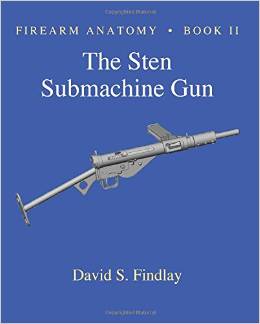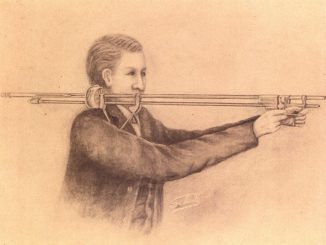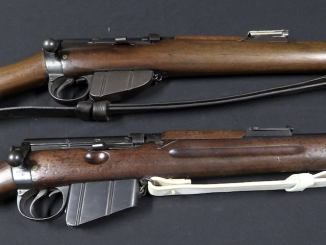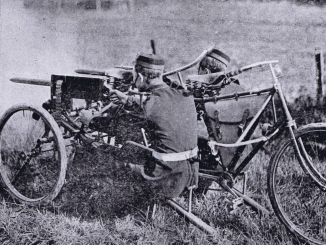 Regular readers may recall that about a year ago I wrote a review of Firearms Anatomy I: The Thompson M1A1 Submachine Gun by David Findlay. It was a very neat book covering the Thompson from a totally different view than other books; it explored the actual mechanical engineering behind how the Thompson operates. Well, Mr. Findlay has just recently released Book II in his Firearms Anatomy series, and this one is on the Sten Submachine Gun.
Regular readers may recall that about a year ago I wrote a review of Firearms Anatomy I: The Thompson M1A1 Submachine Gun by David Findlay. It was a very neat book covering the Thompson from a totally different view than other books; it explored the actual mechanical engineering behind how the Thompson operates. Well, Mr. Findlay has just recently released Book II in his Firearms Anatomy series, and this one is on the Sten Submachine Gun.
The book is similar in layout to the Thompson, with a brief history of the Sten (it is particularly impressive to realize that only 36 days elapsed from initial concept approval to the completion of the first firing prototype, and more than 3.75 million of the guns would eventually be made), followed by several chapters of mathematical and engineering analysis of the design, and a complete set of reverse-engineered technical drawings for a MkII Sten.
The analysis begins with two methods of calculating rate of fire as a function of several variables. The first method is calculations assuming conservation of energy (ie, that the bolt will have an equal amount of energy as the bullet) and the second is using the Working Model 2D software package (the software is not included with the book, to be clear – this is an explanation of the variables used to solve the problem). For a simple blowback submachine gun, the rate of fire is the mathematical heart of the system, and it allows you to understand the impact of changing bolt mass, spring strength, receiver length, friction of the bolt, firing angle, and elasticity of the bolt bouncing off the rear of the receiver. Once you understand the relationship between these factors, you can design a blowback action to fit whatever parameters you like. It’s not the only element of design (others would include trigger mechanism design, magazine design, feed geometry, etc), but it is a particularly important one.
Once we get out of this math, Chapter 4 is a brief discussion of metallurgy and heat treatment. Not much about why specific alloys and heat treats are chosen, but more than you will usually find on what choices are typical for which applications. Chapter 5 covers barrel design – a subject not included in Book I on the Thompson. Barrels are actually rather simple from an engineering perspective, and Findlay uses the chapter to show how one calculates tangential, radial, and axial stresses, and how to arrive at a barrel wall thickness based on those stresses combined with cartridge pressure and material strength.
Chapter 7 is a brief commentary on feed geometry which will provide the interested reader with the basic problems of designing a firearms feed system. It does not get into methods of solving these problems, though, as this work was basically sidestepped on the Sten by using the existing magazine and feed layout from the German MP-28.
I should also take a moment to point out Mr. Findlay’s qualifications for writing a book like this. He has spent an entire career in firearms design, including 26 years at Remington (which did not include any time spent on the new R51), followed by a stint as a designer and engineering lead for Marlin and H&R, and finally his current position as an engineer for Smith & Wesson. If that weren’t enough, he also hold 8 of his own firearms-related patents.
This book on the Sten is a great resource for the aspiring gun designer. It has a lot of the information needed to really understand how this type of firearm works at the purest level, and will point you in the right direction for the questions it doesn’t answer directly. It is printed independently by Mr. Findlay, and available on Amazon:




FYI, the Amazon link did not publish.
It appears to work fine from my end…perhaps you have ad blocking software that is interfering with it?
Oops, I now see you embedded the link in the image. I expected a link after the final “available on Amazon:”
Thank for the blog about this book. I’m going buy it.
Also, a point about it taking 36 days to design and build the 1st STEN. I sure seems that a gun takes a long time to design and make during peace time. But takes almost no time to do so during a war. Guess it’s the old “The amount of time it takes to do something, is exactly the amount of time one has to do it.”
Sheppard and Turpin only needed 36 days to design the Sten because they essentially adapted two existing designs. The Lanchester (a copy of the MP28) and the MP38.
The Lanchester/MP28 supplied the basic structure and feed geometry, plus the searage letoff. This is pretty obvious when you compare the safety/fire selector systems, which are virtually identical; the Sten just houses them in a sheet-metal “box” under the boltway instead of an inletted wooden stock.
The MP38 supplied the basic patterns of how to make the Lanchester-type mechanism work when built form castings and stampings instead of being machined from the solid. (The Lanchester may not have been the Rolls-Royce of SMGs, that being the Thompson, but it was at least the Bentley.)
Other variants borrowed even more from the MP38. The Austen made “down under” used its searage, folding stock, pistol-grip style (except the Austen had two, like a Thompson), and even the telescoping dust-cover tube protecting its recoil spring. The Austen was reliable and generally well-liked, but the Owen turned out to be even more reliable and a lot easier and cheaper to make.
Trivia note; The Lanchester was built by the Sterling Engineering Company for the Royal Navy. In mid-1943, the Army came to Sterling and asked them to develop a new 9mm SMG that would be more accurate and reliable than the Sten but made from stampings instead of machined from stock.
Their head designer, George Patchett, redesigned the Lanchester system to be built from stampings, etc. He also got rid of the wooden stock, put the searage in a pistol grip assembly moved up right under the ejection slot and magazine, and added a pantograph-type folding steel stock. The result looked like a Lanchester action minus the wood stock.
The resulting gun, called the “Patchett”,was still in trials on VE Day. It later became the standard SMG of the Royal Army under the name Sterling, and for many years was about the third most common SMG in the West, after the HKs and the Uzi.
It’s rather amusing to think that the gun which helped “midwife” the Sten gave birth to its successor. Which was basically the original except made like a Sten instead of a Mauser rifle.
It’s even more amusing that the feared Storm Troopers in the Star Wars films have been waving around Sterlings with spiky bits added for almost forty years.
cheers
eon
You have that dead right. I knew about the Lanchester, but it was not until I examined an MP38 that I fully realised where they got the inspiration from. I felt cheated. : )
“Royal Army”
I don’t want to be malicious, but so far I know (at least in first half of 20th century) there was RN (Royal Navy), RAF (Royal Air Force) and Royal Tank Corps but there were not something like “Royal Army”, but only “British Army”. The http://www.arrse.co.uk/community/threads/why-british-army-and-not-royal-army.346/ states that there is not “Royal Army” because the Army don’t have Royal Charter. If you have more precise information please write about “why there is British Army not Royal Army”, I’m not very knowledgeable about Great Britain military organization.
The reason goes back to the English Civil War in the mid-17th century. Even though the Monarchy was restored in 1660, the Parliament remained in control of the Army, which as a whole never gained the Royal Charter. Many parts of it did, however, and therefore the British Army includes “Royal Artillery”, “Royal Corps of Engineers” etc.
http://i958.photobucket.com/albums/ae70/czechthis_bucket/IMG_1708.jpg
Pretty slick looking!
Thanks : ) It took 10 days to figure it out, not 36.
Thanks for the great book reference, Ian; that may just be my Christmas present to myself this year…
“Chapter 7 is a brief commentary on feed geometry which will provide the interested reader with the basic problems of designing a firearms feed system. It does not get into methods of solving these problems, though,(…)”
Note that feeding system is very crucial for proper functioning of automatic firearms (more for full-auto weapons, but also in semi-auto). Apparently the V.A.Degtyarev (DP machine gun designer) has some problems with that:
DP machine has flat pan magazine (for 47 cartridges) when the tank derivate (DT machine gun) and aircraft derivate (DA machine gun) has thicker pan magazine (for 63 cartridges) but smaller in diameter. This improved magazine was designed by G.S.Shpagin.
DK machine gun (DK stands for Дегтярёв Крупнокалиберный – Degtyarev’s Bigbore [machine gun])was a heavy machine gun (12.7×108) feeded from 30-cartridge drum magazine. G.S.Shpagin redesigned this machine gun for the belt-feed and this gun become known as a DShK.
DS machine gun also has some issues with feeding system, but instead of debugging this design, when the war broken out the production of Maxim model 1910 was restarted.
The DP LMG was very reliable, nonetheless. The DS, on the other hand, not so much. Aimo Lahti considered the feed system to be essentially unfixable, although he managed to improve the reliability of the gun somewhat by modifying the gas system and a decelerator to reduce the rate of fire. In its modified form the captured examples of DS (200 of them) were used by the Finnish Army during WW2.
Degtyarev did try to improve the DS himself, producing the DS-42, but the Soviets choose the SG-43 instead. Ironically, the later belt-fed modification of the DP, the RP-46 proved to be quite reliable. Perhaps not surprisingly, the feed mechanism of the RP-46 was derived from the DShK.
“Also, a point about it taking 36 days to design and build the 1st STEN. I sure seems that a gun takes a long time to design and make during peace time. But takes almost no time to do so during a war. ”
http://en.wikipedia.org/wiki/Heinkel_He_162
“The requirement was issued 10 September 1944, with basic designs to be returned within 10 days and to start large-scale production by 1 January 1945.”
“The results of the competition were announced in October 1944, only three weeks after being announced, and to no one’s surprise, the Heinkel entry was selected for production. ”
“The He 162 V1 first prototype flew within an astoundingly short period of time: the design was chosen on 25 September and first flew on 6 December, less than 90 days later”
The He 162 was a very good point defense fighter considering its rapid design, but totally unsuitable to be flown by poorly trained Hitlerjugend pilots — or in fact any novice pilots — as originally envisaged. The whole demented idea was like giving a Formula 1 race car to someone who’s just got a driving license. In the end it did not become a reality and all of the He 162s few combat missions were flown by experienced pilots.
A more familiar aviation example may be the Mustang. It rolled out about 3 months and 10 days after it was commissioned by the RAF (I’m sure the exact time is online somewhere). It didn’t fly for another month-plus because the British Purchasing Commission hadn’t delivered the Allison engine to North American in California; the rollout had a propeller hanging on a wooden armature under the cowlings, IIRC. Unlike the Heinkel 162, the Mustang had time to overcome its early problems and become one of the greatest machines of the war.
are the calculations that are in the book done with the metric system ?
I’m interested, are the technical drawings in the book based, or similar to G. Dmitrieff book “Submachine gun designers handbook” (that has ppsh41 and sten blueprints)?
In that book, calculations for determining rate of fire are presented also, but are kinda confusing or lacking some variables (or Im bad at math:)…
I don’t know – I haven’t seen Dmitrieff’s book.
some of the blueprints of the sten gun that are on the web aren’t that good
http://radikal.ru/users/walther38-12#alb=&img=6005160302
I received my copy of the book from Amazon and have been enjoying it. The RPM and stress analysis is reminiscent of my old college engineering texts where he walks you through the equations and calculations. The equations are truthfully dry reading unless you really like math, but Findlay’s comments and conclusions about the analysis are interesting and worth reading if you are truly a technical gun guy (or are an engineer in the gun industry).
There are lots of history books out there which is probably what more people will relate to, but if you want to be more educated in the factors that go into designing a gun and selecting materials this book has that.
Findlay says he reverse engineered a Sten parts kit to make the drawings.
If you are really looking for a book that covers the design math and science of firearms construction then do not miss the book “BRASSEY’S ESSENTIAL GUIDE TO MILITARY SMALL ARMS: DESIGN PRINCIPLES AND OPERATING METHODS” EDITED By DEREK ALLSOP. This book is a a treasure chest of information and has the necessary formulas and concepts for any Mechanical Engineer or serious student of firearms design.
When I purchased mine in 1970 and at that time I paid 85.00 for it. It is out of print, and I cherish my copy.
I’m enjoying reading these articles. Not much chance in the UK to do much other than read about firearms these days, not where I live anyway.
A small query: you mention conservation of energy between bolt and bullet. Do you mean conservation of momentum? (m1 x v1 ) + (m2 x v2) = 0, where v1 and v2 are the velocities, and therefore vector quantities, the 0 because the system is at rest before the gun is fired. There would have to be a term in there for the escaping gases too to make it properly accurate.